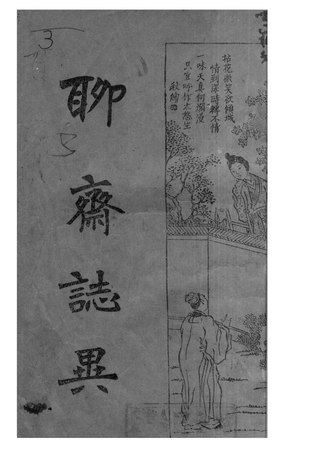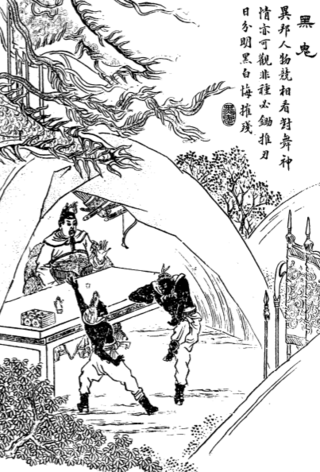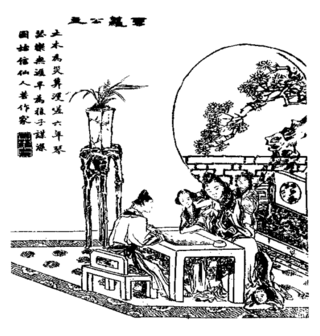
Pu Songling was a Chinese writer during the Qing dynasty, best known as the author of Strange Tales from a Chinese Studio.

Liaozhai zhiyi, sometimes shortened to Liaozhai, known in English as Strange Tales from a Chinese Studio, Strange Stories from a Chinese Studio, Strange Tales from Make-Do Studio, or literally Strange Tales from a Studio of Leisure, is a collection of Classical Chinese stories by Qing dynasty writer Pu Songling, comprising close to 500 stories or "marvel tales" in the zhiguai and chuanqi styles, which according to some critics, served to implicitly criticise societal problems. Written over a period of forty years from the late 1600s and ending in the early 1700s, it circulated in manuscripts that were copied and recopied among the author's friends but did not appear in print until 1766. Since then, many of the critically lauded stories have been adapted for other media such as film and television.

"The Painted Skin" is a short story by the Chinese writer Pu Songling collected in Strange Tales from a Chinese Studio in 1740. Literary critics have recognised it as one of the best and best-known entries in Strange Tales; in particular, its textual detail and in-depth characterisation are lauded. "The Painted Skin" has also received numerous adaptations in popular media, especially in film. The story's original title has become a common phrase in Chinese vocabulary, "a synonym for duplicity that wears an outwardly human face but is inwardly demonic".

"Huang Jiulang" is a short story by Pu Songling first published in the third volume of Strange Stories from a Chinese Studio. The story features He Shican, a homosexual studio owner who becomes smitten with Huang Jiulang, a fox spirit, and their subsequent lives as a reborn government official and the lover of another gay official, respectively. "Huang Jiulang" is notable for being a full-length narrative on homosexuality in China; one of its English translated titles, "Cut Sleeve", alludes to Emperor Ai of Han's same-sex relationship with Dong Xian.

"The Great Sage, Heaven's Equal" is a short story by Pu Songling first published in Strange Stories from a Chinese Studio (1740). It revolves around Shandong native Xu Sheng, who initially rejects the existence of Sun Wukong but gradually becomes a firm devotee of him after encountering him and experiencing his power. The story acts as social commentary on the worship of mythical characters, in this case Sun Wukong. In 2014, it was translated into English by Sidney L. Sondergard.

"The Bookworm" is a short story by Pu Songling first published in Strange Stories from a Chinese Studio (1740). The story revolves around an innocent scholar Lang Yuzhu and his romantic encounter with a celestial being hidden in his books. An English translation of the story by Sidney L. Sondergard was released in 2014.
"The Fornicating Dog" is a short story by Chinese author Pu Songling first published in Strange Stories from a Chinese Studio (1740). The story pertains to a Chinese merchant's spouse, a zoophile who develops sexual relations with the family's pet dog; Pu himself was critical of such phenomena as sexual fixation on animals. It was dropped from early editions, both Chinese and translated, of Liaozhai, notwithstanding Pu's original manuscript, and was translated into English by John Minford in 2006.

"A Sequel to the Yellow Millet Dream", also translated as "Dr Tsêng's Dream", is a short story written by Chinese author Pu Songling in Strange Tales from a Chinese Studio (1740). The story revolves around an ambitious scholar whose dreams of becoming prime minister apparently come true, and his subsequent fall from grace. Inspired by previous works of the same genre, "A Sequel to the Yellow Millet Dream" was received favourably by literary critics.

"The Black Ghosts" is a short story written by Chinese author Pu Songling collected in Strange Tales from a Chinese Studio. It concerns a Chinese official who purchases a pair of "black ghosts", and details how they are exploited. The story was fully translated into English by Sidney L. Sondergard in 2014.

"A Strange Matter Concerning Pigeons", also translated variously as "A Strange Tale of Pigeons" or "A Strangeness of Pigeons", is a short story by Pu Songling first published in Strange Stories from a Chinese Studio (1740). It revolves around Zhang Youliang, an avid pigeon-keeper who befriends a fellow collector and is entrusted to care for a few of his pigeons. The story has been translated into both English and French, and adapted into an art installation.

"Stealing Peaches", also variously translated as "The Peach Theft", "Theft of the Peach", "Stolen Peaches", and "Stealing a Peach", is a short story by Pu Songling, first published in Strange Stories from a Chinese Studio (1740). It is told in first person by Pu himself, and revolves around a magic trick similar to the Indian rope trick; Pu claims to have witnessed it personally as a child.

"Three Incarnations", also translated as "Three Lives", is a short story by Pu Songling first published in Strange Tales from a Chinese Studio which revolves around two men who, during the course of three lifetimes, are in constant conflict with one another.

"The Bird Language" is a short story by Pu Songling, first published in Strange Tales from a Chinese Studio (1740). It is a brief anecdote about a Taoist monk who can communicate with birds, which has been suggested to be a criticism of the corrupt bureaucracy in Pu's time.

"Growing Pears", also variously translated as "Planting a Pear Tree", "Sowing Pears", and "The Wonderful Pear Tree", is a short story by Pu Songling, first published in Strange Tales from a Chinese Studio. Set in ancient China, the story revolves around a miserly pear seller and a Taoist priest.

"Princess Yunluo" is a short story by Pu Songling, first published in Strange Tales from a Chinese Studio (1740). The story follows the misadventures of An Daye — after the titular princess enters his life — and subsequently those of his two sons.

"The Fighting Cricket" is a short story by Pu Songling first published in Strange Tales from a Chinese Studio. Set in a society whose emperor has an obsession with fighting crickets, the story follows a boy who metamorphoses into one such cricket to save his father.

"The Shuimang Herb", also translated as "The Shuimang Plant", is a short story by Pu Songling first published in Strange Tales from a Chinese Studio.

"Jia Fengzhi" is a short story by Pu Songling first published in Strange Tales from a Chinese Studio. The story revolves around the eponymous scholar who, despite being intellectually gifted, struggles to pass the provincial examination until assisted by an immortal who befriends Jia while disguised as a fellow scholar. He unsuccessfully pursues an ascetic lifestyle, and returns to civilisation to discover that a century has elapsed, before becoming a bureaucrat. The story was first partly translated into English by British sinologist Herbert Giles, who described Jia as a "Chinese Rip Van Winkle".

"Fourth Sister Hu" is a short story by Pu Songling, first published in Strange Tales from a Chinese Studio (1740). It revolves around a Chinese scholar who encounters a pair of fox spirits.

"Judge Lu" is a short story written by Pu Songling (1640–1715) and first published in 1766 in Strange Tales from a Chinese Studio. It revolves around a scholar and his friendship with a judge from the underworld, who performs a heart transplant on him and a head transplant on his wife. The story was translated into English by Herbert Giles in 1880.



















